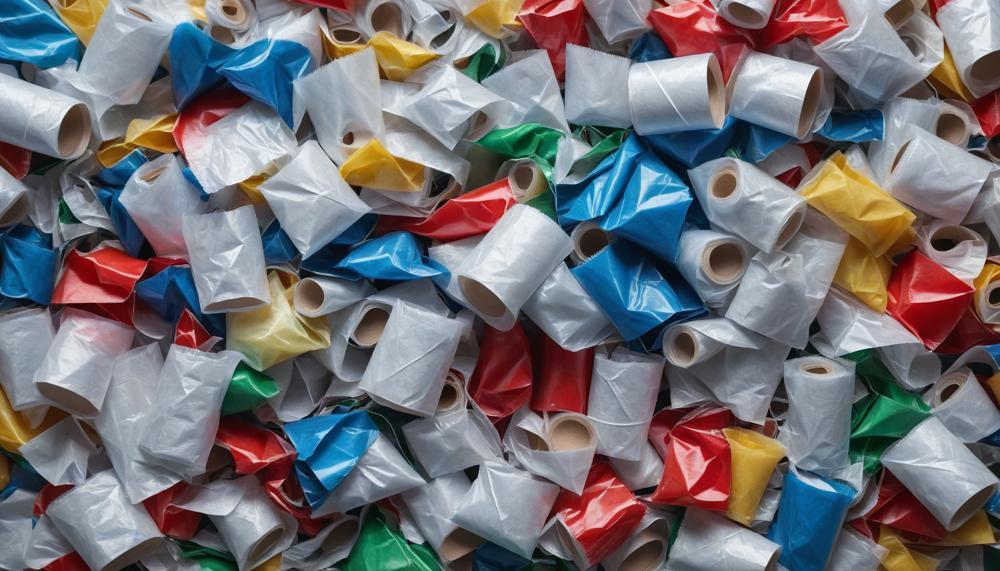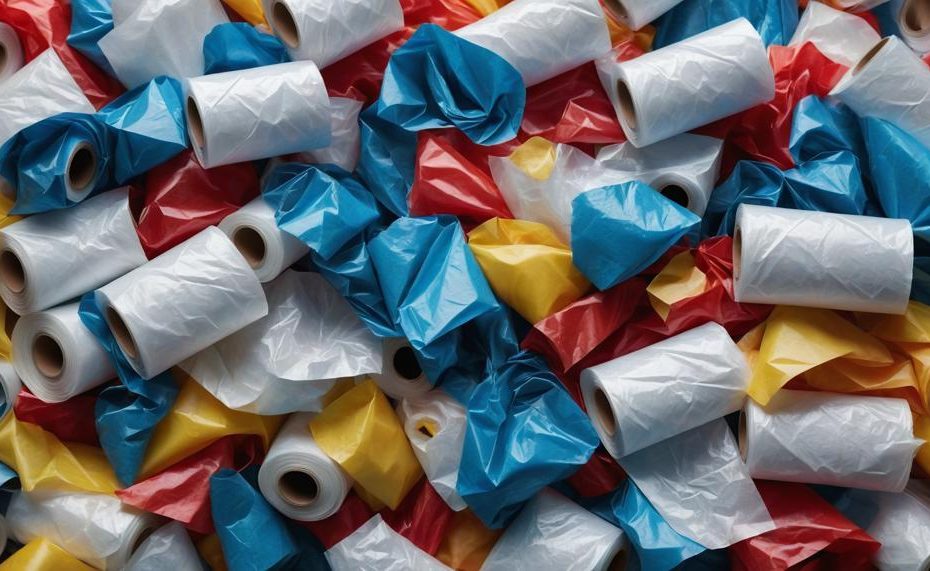No, wax paper cannot be recycled. The wax coating that makes it useful for wrapping food and preventing moisture absorption also makes it unsuitable for recycling. However, there’s more to this story than a simple “no.”
Wax paper is a staple in many kitchens, often used to handle and deliver food. While its utility is undeniable, its environmental impact is less than ideal. The wax coating, typically made of paraffin, prevents it from being processed along with other recyclable papers. This classification as “mixed paper” means it ends up contributing to landfill waste. But don’t toss it just yet. Here are some key takeaways about wax paper recycling and disposal:
- Reusability: If your wax paper isn’t heavily soiled, it can be reused. Simply wipe it with a damp cloth to extend its life.
- Composting: Wax paper made from organic waxes, like soybean-based or vegetable oil wax, is compostable. In the right conditions, it can break down in about 2-6 weeks.
- Art Projects: Paper with crayon drawings also can’t be recycled due to the wax. Instead, consider reusing it for crafts or as wrapping paper.
Understanding these nuances helps us make better choices about waste and sustainability. Stay tuned to learn how you can make the most eco-friendly decisions regarding wax paper and other household items.
Contents
- 1 The types of paper that cannot be recycled include –
- 2 11 Types Of Paper That Cannot Be Recycled:
- 3 What paper cannot be recycled?
- 4 6 Waste Disposal Problems and Solutions (2024)
- 5 50 Affordable Sustainable Clothing Brands
- 6 39 Thrift Shops For Second-Hand Clothes Online
- 7 40 Zero Waste Swaps and Eco-Friendly Essentials (2024)
- 8 Conclusion
The types of paper that cannot be recycled include –
The types of paper that cannot be recycled include:
| Type of Paper | Reason | Additional Notes |
| Waxed Paper | Coated with wax, making it non-recyclable. | Can be composted if coated with organic wax. |
| Food-Contaminated Paper | Grease and food residues interfere with the recycling process. | Includes pizza boxes and used paper plates. |
| Paper with Crayon Drawings | Crayon wax cannot be separated during recycling. | Consider reusing or composting if possible. |
| Paper Towels and Tissues | Often contaminated with substances that hinder recycling. | Generally compostable if not heavily soiled. |
| Glossy or Laminated Paper | Plastic coatings make separation difficult. | Includes some magazines and photo papers. |
| Disposable Cups | Plastic lining prevents effective recycling. | Look for compostable options instead. |
| Carbon Paper | Contains chemicals that are not suitable for recycling. | Dispose of in regular waste. |
| Milk and Juice Cartons | Often contain mixed materials (plastic or aluminium). | Check local recycling programs for specific guidelines. |
Certain types of paper are non-recyclable due to contamination or the presence of non-paper materials. For example, waxed paper and glossy paper are problematic because their coatings cannot be separated from the paper fibres. Food-contaminated paper, such as greasy pizza boxes, disrupts the recycling process because the oils cannot be removed. Similarly, paper towels and tissues are usually contaminated and thus unsuitable for recycling.
For more information on recycling and composting, visit Wikipedia on Paper Recycling.
11 Types Of Paper That Cannot Be Recycled:
No, wax paper cannot be recycled. The coating of wax, plastic, or silicone on wax paper makes it impossible to separate the waxes and coatings from the paper fibres during the recycling process.
Here’s a more detailed explanation:
| Reason | Details | Alternative Disposal Methods |
| Wax Coating | Wax paper is coated with wax, plastic, or silicone, which prevents the paper fibres from being separated and processed in recycling facilities. | Reuse the wax paper for as long as possible before disposal. If the wax paper is made from organic wax (like soybean-based or vegetable oil wax), it can be composted. |
| Contamination | Wax paper often becomes contaminated with food residue, which further complicates the recycling process. | Wipe down lightly soiled wax paper with a damp cloth for reuse. Composting is an option if the wax is organic. |
| Classification | Wax paper is classified as “mixed paper,” which includes materials that are not recyclable due to their composite nature. | Place heavily soiled wax paper in the garbage bin. For more environmentally friendly alternatives, consider using parchment paper or beeswax wraps. |
What paper cannot be recycled?
Certain types of paper cannot be recycled due to various coatings, contamination, or material compositions that interfere with the recycling process. Here’s a detailed list of such paper types:
| Type of Paper | Reason | Additional Information |
| Waxed Paper | Coated with wax | Waxed paper, often used for food wrapping, can’t be recycled but can be composted if the wax is organic. |
| Shredded Paper | Short fibers | Shredding shortens paper fibers, making them less useful in the recycling process. Consider composting or using it as packing material. |
| Wrapping Paper | Coated or laminated | Many wrapping papers have plastic or metallic coatings, making them unsuitable for recycling. Opt for recyclable or reusable wrapping options. |
| Paper Coated with Plastic | Mixed materials | Papers like milk cartons or juice boxes have plastic coatings, which prevent them from being recycled with regular paper. Look for special recycling programs. |
| Receipts | Thermal paper | Most receipts are made from thermal paper, which contains BPA or BPS, harmful chemicals that disrupt recycling. |
| Sticky Paper | Adhesives | Sticky notes or labels have adhesives that can gum up the recycling machinery, making them difficult to process. |
| Paper Contaminated with Food or Liquids | Contamination | Items like pizza boxes, paper towels, napkins, and tissues absorb oils and food residues, contaminating the recycling stream. |
| Parchment Paper | Food waste/oil | Parchment paper used in baking often contains food residue and oils, making it non-recyclable. It can be composted if it’s free from contaminants. |
| Most Tissue Paper | Low fiber quality | Since tissue paper is already made from recycled fibers, it cannot be recycled again. Composting is a better option if clean. |
6 Waste Disposal Problems and Solutions (2024)

Effectively disposing of wax paper in an environmentally-friendly way involves several steps, depending on the type of wax paper and its usage.
| Action | Description | Environmental Impact |
| Choose Eco-friendly Wax Paper | Opt for beeswax or soybean wax coatings; prefer unbleached paper. | Reduces harmful chemicals and supports biodegradability. |
| Reuse | Use the wax paper multiple times before disposal. | Decreases waste generation. |
| Composting | Compost small pieces of wax paper with vegetable or beeswax coatings. | Turns waste into valuable compost. |
| Alternative Uses | Repurpose wax paper for crafts or storage. | Extends the life of the material. |
| Proper Disposal | As a last resort, dispose of in general waste. | Biodegrades slowly in landfills. |
| Use Alternatives | Replace with glass containers or mason jars. | Minimizes single-use waste. |
50 Affordable Sustainable Clothing Brands
Yes, here is a list of 50 affordable clothing brands that are sustainable and eco-friendly. These brands prioritize ethical and sustainable practices in their production process, making them a great choice for environmentally-conscious individuals.
| Brand Name | Country | Price Range |
|---|---|---|
| Everlane | USA | $50-$100 |
| Kotn | Canada | $50-$100 |
| Reformation | USA | $50-$100 |
| Girlfriend Collective | USA | $50-$100 |
| PACT | USA | $25-$50 |
| People Tree | UK | $50-$100 |
| Amour Vert | USA | $50-$100 |
| Tentree | Canada | $25-$50 |
| Eileen Fisher Remade | USA | $50-$100 |
| Patagonia Worn Wear | USA | $50-$100 |
| Nudie Jeans Co. Repair Shop | Sweden | $50-$100 |
| Armedangels | Germany | $50-$100 |
| Organic Basics | Denmark | $50-$100 |
| KnowledgeCotton Apparel | Denmark | $50-$100 |
| Nisolo | Peru/USA | $25-$50 |
| Thought Clothing | UK | $25-$50 |
| Lucy andamp; Yak | UK/India | $25-$50 |
| Outerknown S.E.A. Jeans Program | USA/Peru/Mexico/Portugal/Morocco/Turkey/China/Vietnam/Malaysia/Indonesia/South Africa/Sri Lanka/India/Thailand/Bangladesh/Cambodia/Egypt/Brazil/Italy/Tunisia/Philippines/Latvia/Bulgaria/Romania/Pakistan/Hong Kong/Panama/Spain/Guatemala/Kenya/Nepal/Colombia/Taiwan/South Korea/Singapore/Greece/Slovakia/Czech Republic/France/Uruguay/Croatia/Serbia/Argentina | $25-$50 |
| Indigo Luna Collective | Australia | $25-$50 |
| Boden | UK | $50-$100 |
| Dorsu | Cambodia | $25-$50 |
| Veja | France/Brazil | $50-$100 |
| Groceries Apparel | USA | $25-$50 |
| Monkee Genes | UK | $50-$100 |
| Kowtow | New Zealand | $50-$100 |
| Kotn Factory Bazaar | Egypt | $25-$50 |
| A.BCH | Australia | $50-$100 |
39 Thrift Shops For Second-Hand Clothes Online
For those keen on combining style with sustainability, here are some reputable online thrift shops offering an impressive array of second-hand clothing options:
| Store Name | Description | Website |
| Thrifted | Thrifted specialises in vintage clothing, offering quality secondhand apparel suitable for both festivals and daily wear. They believe in circular fashion, providing excellent brands at reasonable prices. | Thrifted |
| ThredUp | ThredUp is one of the largest online thrift stores, offering a wide variety of second-hand clothing for women, men, and children. They focus on sustainability and offer a clean, user-friendly shopping experience. | ThredUp |
| Depop | Depop blends the social aspects of Instagram with the buying and selling of fashion, where users can follow sellers and discover unique items. It’s especially popular among younger shoppers looking for trendy, vintage pieces. | Depop |
| Poshmark | Poshmark allows users to buy and sell new and gently used clothing, accessories, and more. With a wide range of brands, from high-end to fast fashion, it caters to all styles and budgets. | Poshmark |
| Vestiaire Collective | Focusing on luxury second-hand fashion, Vestiaire Collective offers high-end clothing and accessories at reduced prices. It’s a go-to for those looking to add designer pieces to their wardrobe sustainably. | Vestiaire Collective |
| ASOS Marketplace | ASOS Marketplace features vintage boutiques and independent brands, making it a hub for unique, second-hand fashion. It’s perfect for those seeking both trendy and classic styles. | ASOS Marketplace |
| eBay | eBay remains a classic choice for second-hand shopping, offering a vast range of clothing from various brands. Its auction and buy-it-now options cater to all types of buyers. | eBay |
40 Zero Waste Swaps and Eco-Friendly Essentials (2024)
What are some eco-friendly alternatives to using plastic wrap, such as wax paper, that can also be recycled?
Eco-friendly alternatives to plastic wrap are essential for reducing waste and promoting sustainability. Here are several options that can be recycled:
| Alternative | Description | Recyclability |
| Wax Paper | Wax paper, typically coated with natural wax like beeswax or soy wax, is an excellent alternative. It can be reused multiple times and offers a biodegradable option. | Recyclable if not heavily soiled |
| Bee’s Wrap | Made from organic cotton infused with beeswax, jojoba oil, and tree resin, Bee’s Wrap is a popular reusable wrap. It is flexible and can be used for covering bowls or wrapping sandwiches. | Compostable and recyclable |
| Silicone Food Covers | Stretchable silicone covers can be used to cover bowls, plates, and even cut fruits. These covers are durable, washable, and reusable, reducing the need for single-use plastic. | Not recyclable, but highly durable and reusable |
| Fabric Bowl Covers | Made from cotton or other natural fabrics, these covers come with elastic edges to fit over bowls and dishes. They are machine washable and reusable. | Compostable if 100% cotton; otherwise, check local recycling options |
| Kraft Paper | Kraft paper is a sturdy, brown paper that can be used to wrap food items. It is more eco-friendly than shiny colored wrapping paper and can be recycled easily. | Fully recyclable |
| Aluminium Foil | Aluminium foil can be used as a substitute for plastic wrap. It is durable and can be washed and reused multiple times before recycling. | Recyclable if cleaned properly |
Using these alternatives not only helps in reducing plastic waste but also ensures that the materials used are recyclable or compostable, aligning with zero waste principles.
Conclusion
While wax paper is a common household item, its recycling prospects are quite limited due to its waxy coating. This coating, often made of paraffin or other non-recyclable substances, hinders the separation of paper fibers during the recycling process. Consequently, wax paper generally contributes to landfill waste rather than being repurposed into new paper products.
However, there are several ways to manage wax paper more sustainably. Lightly soiled wax paper can be reused after a simple wipe-down, extending its useful life. For those wax papers coated with organic materials like soybean-based or vegetable oil wax, composting becomes a viable option. These types of wax paper can decompose in composting conditions within a few weeks.
Creative reuse is another avenue. Wax paper can be repurposed for art projects or used as a protective layer in various household tasks. For instance, paper with crayon drawings, also non-recyclable due to wax, can find new life in crafts or wrapping.
Understanding the limitations and alternative uses of wax paper empowers us to make environmentally conscious choices.





